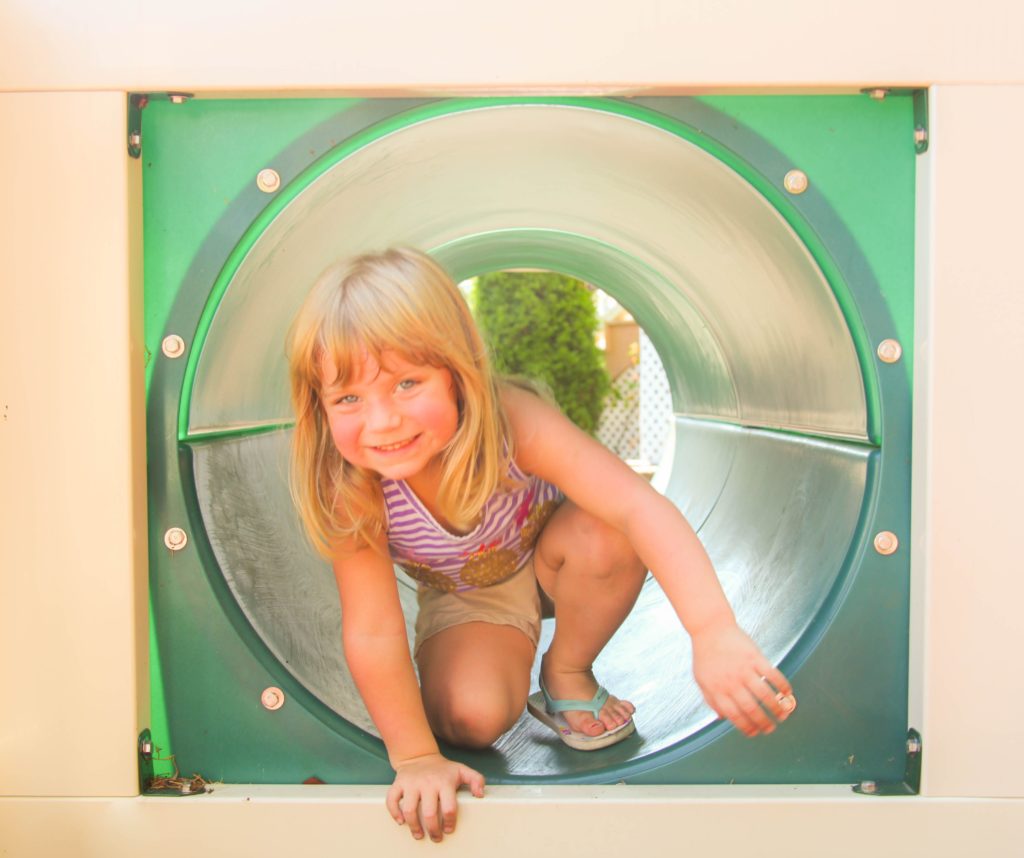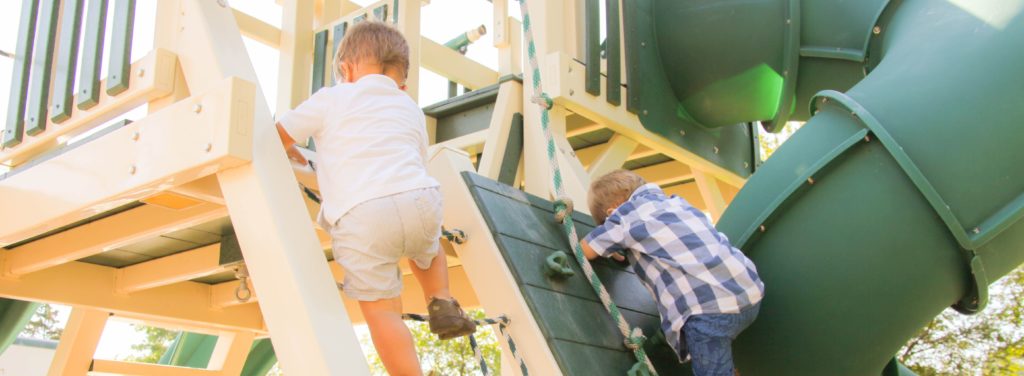Playgrounds are the perfect place for children to explore and let their imaginations run wild. Feeling the fresh breeze as they swing or slide through the air is truly euphoric. However, without proper playground rules and regulations, children may put themselves at risk or become injured. To avoid any potential hazards, understand the importance of playground rules and why they should be instated for your playset, whether it’s located at your home or at a commercial facility such as a daycare, school, or park.
The Importance of Playground Rules
According to the Centers for Disease Control and Prevention (CDC), hospitals and urgent care establishments treat more than 200,000 children ages 14 and younger each year for injuries caused by playground play. Upon taking a closer look, children ages 5 to 9 are most at risk for injuries than any other age group. The most common playground-related injuries include:
- Broken bones
- Bruises
- Cuts
- Bloody noses
- Knocked-out teeth
- Black eyes
- Head injuries
- Dislocations
- Contusions
- Sprains
As a parent, teacher, or supervisor, it’s your job to ensure the children you’re looking after are playing in a safe way. That’s why it’s so vital to incorporate playground regulations and begin teaching good manners on the playground early on.
What to Look Out for Prior to Playing
Before children step foot onto a playground or begin playing on a playset, it’s important to carefully inspect the equipment. Run through this checklist any time you plan on having your children play on a playground.
- Before allowing children to play on a public, commercial playset, see if it has been inspected by a Certified Playground Safety Inspector (CPSI). They will ensure that the playset is structurally sound and safe to play on.
Check for any hazards that could possibly harm children such as rusted metal, splintered wood, or broken components. - Ensure the playground equipment is age appropriate. Playgrounds are generally designed for various age groups and children can be put at risk for injuries if they play on playground equipment that isn’t suitable for their age.
- Take a look at any openings on the playset. Children have a tendency to look in openings, putting them at risk for getting their head stuck. To avoid this, any openings should be smaller than 3.5” or larger than 9” in length and width.
- Ensure proper playground surfacing is being used. You should avoid having your children play on playground equipment that is placed over concrete, asphalt, blacktop, or grass, as these surfaces aren’t forgiving to falls. Playground equipment should be over wood chips, rubber mulch, or sand. Rubber safety pads should also be strategically placed in areas where there is a lot of landing or impact, such as at the bottom of slides.
- If you’re playing in the summertime, check to see if any metal components or handrails are hot to the touch. If the playset is in direct sunlight, it may be too hot to play on.
Playground Safety Rules for Kids

Once you’ve confirmed the playground is safe to play on, talk to the children you’re supervising about specific playground rules they should follow. By repeating these rules every time they play, you can help them remember to use good manners on the playground. It will also assist in reducing any injuries or emergency hospital and urgent care visits.
- Never Play Without Supervision — Always have a parent or other adult with you as you play on the playground.
- No Roughhousing — You should refrain from wrestling with other children on the playground equipment.
- Be Respectful — Don’t push or shove other children and take turns playing on the equipment. Play nicely and treat others the way you would want to be treated.
- Make Sure the Coast is Clear — Check your surroundings and ensure there’s a clear space when planning to slide down a slide or jump off a piece of equipment.
- No Bikes or Backpacks — Leave bikes and backpacks on the outside of the playground area to prevent tripping.
- Take Off Your Helmet — If you’re wearing a bicycle helmet, take it off before playing on the playset so you don’t accidentally get stuck.
- Only Play on a Dry Playset — Never play on a wet playset, as it can lead to slips and falls.
- Use Equipment Properly — Don’t stand on the swings and always slide down slides with your feet first.
- Keep the Playground Clean — Don’t throw trash on the ground. Place any trash you have in a playground waste bin.
- See Something, Say Something — If there’s a problem or you see someone get hurt, let an adult know.
Expert Playground Safety Q&A
If you’re looking for additional playground safety expertise, we have exactly what you need! Swing Kingdom is very lucky to have Phi Viet Le as a team member. Not only does he keep operations at Swing Kingdom running seamlessly, but he is also a Certified Playground Safety Inspector. He’s taken the time to answer the following questions to better help you understand playground rules, regulations, inspections, and safety.
What Are The Requirements to Become a CPSI?
You must undergo a two-day, hands-on classroom training on how to apply the American Society for Testing and Materials (ASTM) standards and the Consumer Product Safety Commission (CPSC guidelines to playground environments. After the training, you must complete a written test and score greater than 70% to gain the certification.
How Does Being a CSPI Help You?
It allows me to establish a system of repair processes for our customers, identify hazardous design on our equipment, and establish a routine inspection system for both the customer and production.
What Type of Safety Issues Do You Look Out for On New Designs?
I usually look at all the equipment layout involved with the design for correct spacing, making sure nothing is too close to each other, to avoid any entrapments. I also make sure that play components are appropriate for the age group they were created for.
What Safety Mistakes Do Some Manufacturers Make When Designing Their Products?
The danger of head and neck entrapment is one of the most common issues I’ve found in playground equipment. Any opening should really be designed to less than 3½ inches or more than 9 inches. When creating a play system there are plenty of other blind spots that they will miss on the equipment, if they don’t know what to look for.
What Safety Aspects Do People Often Overlook When Purchasing or Installing a Playset?
Having a safety surfacing under the playset goes a long way. It does not necessarily prevent injuries, but it does minimize the after-effects of a fall, which is the number one cause of playground injuries.
What’s the Best Way to Prevent Children from Falling Off Playsets?
This is the checklist of recommendations I make to reduce the number of falls from playsets. But, it essentially comes down to having the right size barrier for the appropriate tower height.
- Platforms above 30 inches and up to 48 inches high should have a guardrail at least 25 inches high.
- Platforms above 48 inches and up to 72 inches high should have a protective barrier (not a guardrail) at least 27 inches high.
- Platforms over 72 inches high should have a protective barrier at least 33 inches high.
- These high platforms also should have an intermediate standing surface where a child can stop their ascent and choose another route to descend.
- Slide platforms greater than 200 square inches should have a guardrail or barrier on all sides, except the entry and exit side. The choice of guardrail or barrier is dependent on the platform height as described above.
- Protective barriers are not areas of intended play. There should be no crossbars or toeholds that assist children in climbing over the barrier. Openings should be less than 3½ inches in width.
- Guardrails intended to double as climbers should have no openings that would allow a head or neck entrapment to occur (between 3½ and 9 inches).

